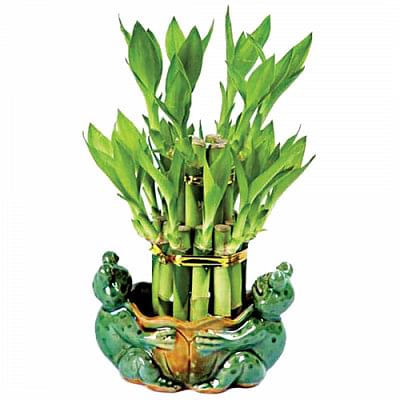Growing bamboos indoors and around the home

Here are some things to keep in mind if you plan on bringing some bamboo home.
Picking the perfect bamboo
Lucky bamboos are the best option for those who are looking to add something indoors. In some cultures, lucky bamboos are believed to bring abundance and good luck. This trait leads them to be frequently used for Feng shui. Lucky bamboos are technically not bamboos at all, and have actually acquired the name due to visual similarities.
If you wish to add bamboo to your garden or roof top, you have the choice of either going for running bamboos or clumping bamboos. All bamboos spread via rhizomes, but the nature of the rhizomes determines how rapidly a bamboo will spread. If you are new to growing bamboo, it is best to purchase clumping bamboos. Clumping bamboos usually grow in clusters and spread more gradually than running bamboos, making maintenance easier. It is better to get mature bamboo from nurseries than to start from young tender ones if you are new to them.
Growing medium
Indoors, lucky bamboo can be grown in pebbles, soil, or plain water. Nevertheless, they usually prefer to grow in soil, or a vase packed with pebbles. If you go for soil, make sure it is fertile and well-draining. If you would rather use pebbles, ensure that they are densely packed and filled with a few inches of water.
Ideally, the soil for growing clumping bamboo outdoors should be fertile, slightly acidic, and well drained but moist. Make sure to grow your outdoor bamboo in a container or within below-ground barriers if you are especially worried about them invading the rest of your garden.
Placement and Design
Indoors, lucky bamboos are best placed in partial shade and indirect light. Unlike bamboo grown outdoors, direct light can easily make its leaves scorch. According to Feng shui, lucky bamboo symbolises growth, nobility, flexibility and an open heart. If you want to dabble in a bit of Feng shui, place your lucky bamboo near the entrance. This is believed to bring growth, stability and harmony to the family.
When placed on a study or work desk, lucky bamboo is thought to help with growth and expansion in one's career.
Outdoors, clumping bamboos do well in direct sunlight. Clumping bamboo can be grown into a hedge or screen outdoors, bordering your garden. They can also be grown in containers of different sizes to create mini bamboo forests on your roof.
Bamboos may be a great option as background plants as they tend to grow well with both annuals and perennials if maintained well.

Water
Lucky bamboo growing in soil should be watered every five days, or once a week. If you choose pebbles as your medium, make sure that the water and pebbles cover most roots at all times.
Although outdoor bamboos grow best in moist soil, they should not be overwatered. Outdoor bamboos are usually more resilient to drought than over watering. You should either water once a week, making sure that the soil is drenched but not soggy, or do frequent but shallow watering.
Care and maintenance
To ensure that the lucky bamboo grows straight and tall, make sure to give it adequate light. If it starts stretching, this may be a hint that the placement is too dim for the lucky bamboo. As lucky bamboos are generally known to be prone to stretching, make sure to turn your plant by a quarter every few days to avoid stretching and coiling. Although offshoots can be pruned, it is best to leave the main stalk alone.
Prune offshoot bamboos growing outside makeshift boundaries when it comes to outdoor clumping bamboos. The tops can also be pruned and manicured easily too, with the right tools.
If the bamboo gets too invasive, you may want to create a trench around the designated planting area and fill it with peat moss or coco peat. You may also need to prune the roots of the clumping bamboo once every two years to keep maintenance at its peak.
Photo: Collected

 For all latest news, follow The Daily Star's Google News channel.
For all latest news, follow The Daily Star's Google News channel. 



Comments